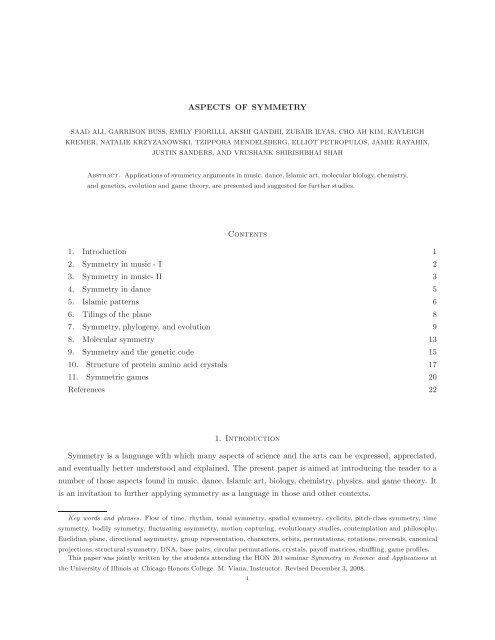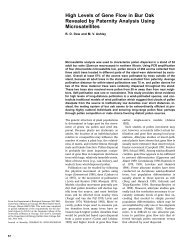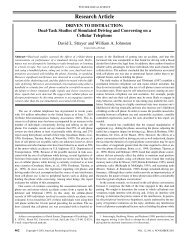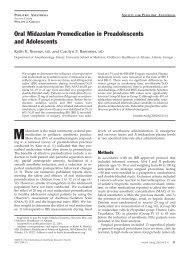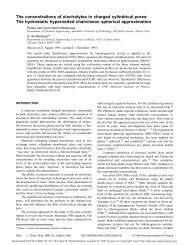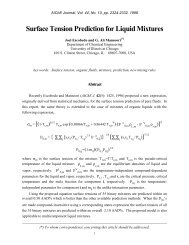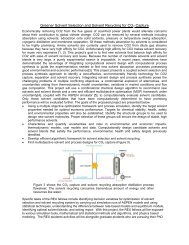ASPECTS OF SYMMETRY Contents 1. Introduction 1 2. Symmetry in ...
ASPECTS OF SYMMETRY Contents 1. Introduction 1 2. Symmetry in ...
ASPECTS OF SYMMETRY Contents 1. Introduction 1 2. Symmetry in ...
Create successful ePaper yourself
Turn your PDF publications into a flip-book with our unique Google optimized e-Paper software.
<strong>ASPECTS</strong> <strong>OF</strong> <strong>SYMMETRY</strong><br />
SAAD ALI, GARRISON BUSS, EMILY FIORILLI, AKSHI GANDHI, ZUBAIR ILYAS, CHO AH KIM, KAYLEIGH<br />
KREMER, NATALIE KRZYZANOWSKI, TZIPPORA MENDELSBERG, ELLIOT PETROPULOS, JAMIE RAYAHIN,<br />
JUSTIN SANDERS, AND VRUSHANK SHIRISHBHAI SHAH<br />
Abstract. Applications of symmetry arguments <strong>in</strong> music, dance, Islamic art, molecular biology, chemistry,<br />
and genetics, evolution and game theory, are presented and suggested for further studies.<br />
<strong>Contents</strong><br />
<strong>1.</strong> <strong>Introduction</strong> 1<br />
<strong>2.</strong> <strong>Symmetry</strong> <strong>in</strong> music - I 2<br />
3. <strong>Symmetry</strong> <strong>in</strong> music- II 3<br />
4. <strong>Symmetry</strong> <strong>in</strong> dance 5<br />
5. Islamic patterns 6<br />
6. Til<strong>in</strong>gs of the plane 8<br />
7. <strong>Symmetry</strong>, phylogeny, and evolution 9<br />
8. Molecular symmetry 13<br />
9. <strong>Symmetry</strong> and the genetic code 15<br />
10. Structure of prote<strong>in</strong> am<strong>in</strong>o acid crystals 17<br />
1<strong>1.</strong> Symmetric games 20<br />
References 22<br />
<strong>1.</strong> <strong>Introduction</strong><br />
<strong>Symmetry</strong> is a language with which many aspects of science and the arts can be expressed, appreciated,<br />
and eventually better understood and expla<strong>in</strong>ed. The present paper is aimed at <strong>in</strong>troduc<strong>in</strong>g the reader to a<br />
number of those aspects found <strong>in</strong> music, dance, Islamic art, biology, chemistry, physics, and game theory. It<br />
is an <strong>in</strong>vitation to further apply<strong>in</strong>g symmetry as a language <strong>in</strong> those and other contexts.<br />
Key words and phrases. Flow of time, rhythm, tonal symmetry, spatial symmetry, cyclicity, pitch-class symmetry, time<br />
symmetry, bodily symmetry, fluctuat<strong>in</strong>g asymmetry, motion captur<strong>in</strong>g, evolutionary studies, contemplation and philosophy,<br />
Euclidian plane, directional asymmetry, group representation, characters, orbits, permutations, rotations, reversals, canonical<br />
projections, structural symmetry, DNA, base pairs, circular permutations, crystals, payoff matrices, shuffl<strong>in</strong>g, game profiles.<br />
This paper was jo<strong>in</strong>tly written by the students attend<strong>in</strong>g the HON 201 sem<strong>in</strong>ar <strong>Symmetry</strong> <strong>in</strong> Science and Applications at<br />
the University of Ill<strong>in</strong>ois at Chicago Honors College. M. Viana, Instructor. Revised December 3, 2008.<br />
1
<strong>2.</strong> <strong>Symmetry</strong> <strong>in</strong> music - I<br />
Mank<strong>in</strong>d has always had a strong connection with music. From the almost hypnotic tap-tap-tap of tribal<br />
drums to <strong>in</strong>tricate and harmonious arias and concertos, music touches people <strong>in</strong> a very unique way. What<br />
is more <strong>in</strong>terest<strong>in</strong>g is the fact that all music seems to follow some universal rules of symmetry. These<br />
symmetries, of course, go beyond the strict and static mathematical symmetries, however, because they<br />
evolve both <strong>in</strong> musical time and space. This accounts for the numerous violations of symmetry that we see<br />
<strong>in</strong> almost all music.<br />
Music and the flow of time. While study<strong>in</strong>g musical symmetry, one will f<strong>in</strong>d that music and time are <strong>in</strong>separable,<br />
and can almost be considered as one <strong>in</strong> the same th<strong>in</strong>g. Music must adhere to the constant flow of<br />
time. This, <strong>in</strong>evitably, forces any composition to conta<strong>in</strong> certa<strong>in</strong> structural elements, and these elements can<br />
be arranged <strong>in</strong> a symmetrical manner. For example, a song is comprised of formal parts or sections; there is<br />
an <strong>in</strong>tro, chorus or some other type of variant, and an outro. If the <strong>in</strong>tro and the outro are exactly the same,<br />
we f<strong>in</strong>d that the song is perfectly symmetrical with respect to its structure; it has an A-B-A framework. This,<br />
however, is usually not the case; the <strong>in</strong>tro/outro are rarely identical. Musicians use variation to captivate<br />
their audience, but variation is also important to further the development of any repetition. Repetition<br />
requires contrast and -vice versa- contrast demands repetition [1].<br />
Rhythm. Another association between music and time is rhythm; a song’s pace is <strong>in</strong>fluenced heavily by its<br />
rhythm. A guitarist will use up and down strokes on the str<strong>in</strong>gs with a steady rhythm, us<strong>in</strong>g four strums<br />
per second, eight strums per second, etc. Therefore, the symmetry of a song can be found <strong>in</strong> a change <strong>in</strong> this<br />
rhythm. An example of this would be a change of 4st/s (four strums per second) to 8st/s, and then back to<br />
4st/s. This is another form of the A-B-A style of symmetry.<br />
This up and down strum will also create a symmetry with<strong>in</strong> notes. The down strums produce a note<br />
beg<strong>in</strong>n<strong>in</strong>g from the E str<strong>in</strong>g and progress<strong>in</strong>g <strong>in</strong> the follow<strong>in</strong>g manner: E,A,D,G,B,E. An upward strum will<br />
produce a mirror image (E,B,G,D,A,E) of this set. In this sense, any chords played with an alternat<strong>in</strong>g up<br />
and down strum will have this mirror symmetry, along with the symmetry of the rhythm.<br />
Tonal symmetry. Music also f<strong>in</strong>ds symmetry with<strong>in</strong> its tonal structure. Musical tones vary from deep, muted<br />
notes to high-pitch, resonat<strong>in</strong>g notes. Kempf [1] describes a song’s change <strong>in</strong> tone us<strong>in</strong>g a ra<strong>in</strong>bow as an<br />
example. The music with<strong>in</strong> a song will vary from low tones to high ones, and then back down to low tones,<br />
much like the bend <strong>in</strong> a ra<strong>in</strong>bow. When listen<strong>in</strong>g to a composition, one can readily pick out the up and<br />
down shifts <strong>in</strong> tone. Here we can discover another symmetry with<strong>in</strong> the tones; a vertical symmetry. Aga<strong>in</strong>,<br />
musical symmetry does not adhere to strict rules. A musician will attempt to vary the shifts <strong>in</strong> tone, based<br />
on which sequence of notes is most pleas<strong>in</strong>g to hear. For example, a shift from a G-chord to a D-chord may<br />
sound more pleas<strong>in</strong>g than a shift from a C-chord to a Bm-chord. These shifts <strong>in</strong> chords can be expla<strong>in</strong>ed by<br />
tonal distances.<br />
Us<strong>in</strong>g the guitar as an example, one can see the physical distance between two chords. The F and G-<br />
chords are placed two frets apart on the neck of the guitar, and can be played <strong>in</strong> an alternat<strong>in</strong>g fashion. In<br />
do<strong>in</strong>g so, a guitarist can create a symmetry of the notes(F-G-F-G), which have a tonal distance of two frets,<br />
with respect to the guitar.
The reader will appreciate the opportunity of compar<strong>in</strong>g the notions of horizontal (repetition) and vertical<br />
(tonal) symmetries <strong>in</strong> music with the underly<strong>in</strong>g mathematical structure (the Kle<strong>in</strong> group of symmetries of<br />
the planar rectangle) implicit <strong>in</strong> the narrative of [1].<br />
3. <strong>Symmetry</strong> <strong>in</strong> music- II<br />
It may seem counter<strong>in</strong>tuitive to apply so potentially rigid a mathematical concept as symmetry to someth<strong>in</strong>g<br />
as flexible and progressive as form <strong>in</strong> tonal music. Yet, it proves <strong>in</strong>structive to measure degrees of<br />
exact symmetrical correspondence. <strong>Symmetry</strong>, perhaps the most basic of what Hegel calls ”the relations<br />
of the abstract understand<strong>in</strong>g,” forms a virtually unavoidable constant aga<strong>in</strong>st which we can evaluate the<br />
boundaries of art and, <strong>in</strong>deed, life itself [2].<br />
Spatial symmetry. In its modern def<strong>in</strong>ition, symmetry applies to the quality that allows certa<strong>in</strong> objects,<br />
patterns, or sets of relationships to rema<strong>in</strong> <strong>in</strong>variant when subjected to a certa<strong>in</strong> group of transformations.<br />
In two-dimensional space this group comprises the geometric transformations of rotations, reflections, and<br />
translations (displacement). For <strong>in</strong>stance, a square has four axial reflections (four axes about which it can<br />
be reflected) and fourfold rotational symmetry (four positions to which it can be rotated about a central<br />
po<strong>in</strong>t).<br />
Figure 3.<strong>1.</strong> <strong>Symmetry</strong> transformation of a square, from Symmetrical Form and Common-<br />
Practice Tonality.<br />
Pitch-class symmetry. It conta<strong>in</strong>s only twelve locations. Pitch-Class symmetry has significant symmetrical<br />
properties of its own: twelvefold rotational and twelvefold transpositional symmetry. The rotational character<br />
stems from cyclicity: each pitch class returns to its <strong>in</strong>itial position after travers<strong>in</strong>g the other eleven equidistant<br />
positions by chromatic scale or circle of fifths. Cyclicity also makes translation equivalent to rotation, s<strong>in</strong>ce<br />
<strong>in</strong> this space the former also eventually leads back to its start<strong>in</strong>g po<strong>in</strong>t. A pitch-class set with transpositional<br />
symmetry, then, is one that divides pitch-class space <strong>in</strong>to equidistant smaller segments, reduc<strong>in</strong>g its twelvefold<br />
symmetry to a more limited order.<br />
Whereas transpositional symmetry is derived from equal octave division, <strong>in</strong>version symmetry is derived<br />
from correspond<strong>in</strong>g placement about a reflection l<strong>in</strong>e that divides the pitch-class space <strong>in</strong>to two mirror<strong>in</strong>g<br />
halves. For example, (0,2,7) reflects about a l<strong>in</strong>e from 1 to 7, (1,2,4,7,9,10) about a l<strong>in</strong>e from 51/2 to 111/2<br />
(recall<strong>in</strong>g that reflections occur at half the rotational angle).
Figure 3.<strong>2.</strong> <strong>Symmetry</strong> transformation of a square, from Symmetrical Form and Common-<br />
Practice Tonality.<br />
Temporal symmetry. Temporal symmetry forms an essential component of all dynamic symmetrical systems,<br />
such as planetary motions, or the rotations of hands on a clock face (as opposed to the static clock face<br />
itself), or the passage of musical events (as opposed to atemporal pitch-sets).<br />
A temporally symmetric system, then, is one <strong>in</strong> which an event occurs regularly, separated by a recurr<strong>in</strong>g<br />
time-<strong>in</strong>terval, and thus rema<strong>in</strong>s <strong>in</strong>variant under displacement by that <strong>in</strong>terval. The basic idea is analogous<br />
to that of two-dimensional translational symmetry: correspond<strong>in</strong>g to the regular recurrence of patterns <strong>in</strong><br />
space, an event recurs at regular <strong>in</strong>tervals <strong>in</strong> time. Model<strong>in</strong>g time as a horizontal l<strong>in</strong>e, temporal translation<br />
can be represented as <strong>in</strong> Figure 3.3, correspond<strong>in</strong>g to the spatial representation <strong>in</strong> Figure 3.<strong>1.</strong> From this it<br />
follows that both spatial and temporal translation encompass two related components: a recurr<strong>in</strong>g unit of<br />
space or time<br />
Figure 3.3. <strong>Symmetry</strong> transformation of a square, from Symmetrical Form and Common-<br />
Practice Tonality.<br />
Conclusion and summary. The concept of symmetry can be applied to a wide range of phenomena, <strong>in</strong>clud<strong>in</strong>g<br />
physical objects (elementary particles, geometric figures, planetary systems), abstract systems (laws<br />
of physics, mathematical relations, pitch systems), and processes tak<strong>in</strong>g place <strong>in</strong> time (chemical reactions,<br />
biological processes, a segment of music). <strong>Symmetry</strong>, even strictly def<strong>in</strong>ed, is essentially a matter of degree.<br />
Absolute symmetry (<strong>in</strong>f<strong>in</strong>ite degrees of all possible symmetries) means absolute <strong>in</strong>dist<strong>in</strong>guishability; and
while the idea provides an essential conceptual limit, it is of little practical value. Objects that are symmetrically<br />
structured normally possess only partial symmetry which can be viewed as the result of a break <strong>in</strong> a<br />
more encompass<strong>in</strong>g symmetry.<br />
4. <strong>Symmetry</strong> <strong>in</strong> dance<br />
<strong>Introduction</strong>. The ma<strong>in</strong> hypothesis proposed <strong>in</strong> [3] is that quality of dance can reveal bodily symmetry, or,<br />
us<strong>in</strong>g the term<strong>in</strong>ology of evolutionary studies, fluctuat<strong>in</strong>g asymmetry (FA). This hypothesis was formulated<br />
with basis on the theory that symmetry shown <strong>in</strong> dance movements can be considered as a measure of<br />
developmental stability. The experiment described <strong>in</strong> [3] and conducted <strong>in</strong> Jamaica (a society <strong>in</strong> which<br />
danc<strong>in</strong>g is important <strong>in</strong> the lives of both sexes) found that there is a strong positive association between FA<br />
and danc<strong>in</strong>g ability. It was also found that these associations between FA and danc<strong>in</strong>g ability were stronger<br />
<strong>in</strong> men than <strong>in</strong> women.<br />
Fluctuat<strong>in</strong>g asymmetry and genetic or phenotypic quality of the dancer. It was Darw<strong>in</strong> who first to suggested<br />
that dance is a sexually selected courtship signal. The justification for study<strong>in</strong>g the dancer’s FA<br />
comes from the observations that (i) FA is <strong>in</strong>versely correlated with developmental stability, def<strong>in</strong>ed as “an<br />
organisms ability to reach an adaptive endpo<strong>in</strong>t despite ontogenetic perturbations” [3]; (ii) that <strong>in</strong>creased<br />
FA is associated with morbidity, mortality, poor fecundity, and other variables l<strong>in</strong>ked to natural and sexual<br />
selection, and (iii) that FA is <strong>in</strong>versely associated with attractiveness based on a person’s odor, voice, and<br />
facial appearance.<br />
Motion captur<strong>in</strong>g. The technique of motion-captur<strong>in</strong>g is generally used <strong>in</strong> sports and medical studies to<br />
assess potential confounds with<strong>in</strong> dance evaluations such as cloth<strong>in</strong>g, culture, physical attractiveness and<br />
fluctuat<strong>in</strong>g asymmetry. This technology is used to actively extract complex movement <strong>in</strong> the form of film<br />
animation. From the animations, the <strong>in</strong>vestigators may attend to those traits <strong>in</strong>tr<strong>in</strong>sic to danc<strong>in</strong>g without<br />
distractions from the dancer.<br />
Experimental design. The <strong>in</strong>vestigators chose 40 dance animations from the motion-captur<strong>in</strong>g of 183 human<br />
dancers conducted <strong>in</strong> 2004 <strong>in</strong> Southfield, Jamaica, based on two measures of FA. Those <strong>in</strong> the top third of<br />
both measures were classified as asymmetrical (n=20) and those <strong>in</strong> the bottom third (n=20) were categorized<br />
as symmetrical.<br />
The traits that were measured were the elbow, wrist, knee, ankle, foot, third digit, fourth digit, and ears.<br />
These traits were chosen because they revealed true fluctuat<strong>in</strong>g asymmetry and have proven useful <strong>in</strong> past<br />
studies [3]. When look<strong>in</strong>g at the videos created, no dancers could be identified as a specific dancer <strong>in</strong> the<br />
film, even sex was unable to be identified (although female evaluators were better at detect<strong>in</strong>g the sex of the<br />
dancer than male evaluators). These evaluators based their judgments on movements, rather than the sex<br />
of the dancer.<br />
Experimental results. The experiment showed that there is a significant effect of symmetry and sex on dance<br />
ability. The experiment showed that symmetrical males were evaluated as significantly better dancers than<br />
asymmetrical males (as were females). It was also found that symmetrical males were significantly better
dancers than symmetrical females. In contrast, there was no statistically significant difference <strong>in</strong> dance<br />
ability between asymmetric males and females.<br />
In this experiment, the relative preference for symmetrical dancers was also tested. More specifically,<br />
to test for sex differences between evaluators and the strength of preference for symmetrical <strong>in</strong>dividual<br />
dancers. Relative preference for symmetrical dancers was constructed by subtract<strong>in</strong>g dance evaluations<br />
given to asymmetrical dancers by dance evaluations given to symmetrical dancers. Therefore, higher scores<br />
<strong>in</strong>dicated stronger preferences for symmetrical dancers. From this it was determ<strong>in</strong>ed that female evaluators<br />
had stronger relative preferences for symmetrical male dancers but there was no sex difference <strong>in</strong> dance<br />
rat<strong>in</strong>gs of symmetrical females. It was concluded that male evaluators gave higher rat<strong>in</strong>gs to the dances of<br />
females.<br />
F<strong>in</strong>ally, it was found that FA <strong>in</strong> male evaluators was negatively associated with relative preference for<br />
dances performed by symmetrical women. But, they came across no significant association between female<br />
evaluator FA and preferences for symmetrical male dancers.<br />
Conclusion. As motion-capture technology gets better, stor<strong>in</strong>g dance <strong>in</strong> a mathematical form, the <strong>in</strong>vestigators<br />
hope to study <strong>in</strong> more detail which patterns of dance movement are associated with quality of dance and<br />
fluctuat<strong>in</strong>g asymmetry of the dancer. A potential application of that methodological improvement would<br />
be the test<strong>in</strong>g the hypothesis of whether or not dance ability correlates with reproductive success <strong>in</strong> that<br />
society.<br />
5. Islamic patterns<br />
<strong>Introduction</strong>. Islamic symmetrical patterns have a rich tradition that can be utilized <strong>in</strong> many ways, whether<br />
it is simple enjoyment, an <strong>in</strong>strument of <strong>in</strong>struction for students rang<strong>in</strong>g from toddlers to adults, and f<strong>in</strong>ally<br />
a means of contemplation and philosophy [4].<br />
Figure 5.<strong>1.</strong> The name Muhammad, show<strong>in</strong>g symmetry <strong>in</strong> calligraphic writ<strong>in</strong>g. From [4].<br />
Enjoyment. <strong>Symmetry</strong> plays an important role <strong>in</strong> Islamic culture, and one of the first places to look for it is<br />
<strong>in</strong> specialized Arabic writ<strong>in</strong>g, called calligraphy. Arabs have raised their art form of writ<strong>in</strong>g <strong>in</strong> Arabic while
<strong>in</strong>corporat<strong>in</strong>g symmetry that a simple name can be made to stand out as an art piece by itself. For example,<br />
Figure 5.1 shows the name Muhammad written <strong>in</strong> calligraphy.<br />
Aside from calligraphy, many other examples relat<strong>in</strong>g to symmetry <strong>in</strong> Islam can be found. An important<br />
one relates to home decoration <strong>in</strong> the form of carpet rugs. Arabs have a long history of carpet weav<strong>in</strong>g, and<br />
as such, the carpet is perhaps the most visible and most easily expressed form of decoration [4]. Oftentimes<br />
the carpet will have symmetrical patterns on it, an example be<strong>in</strong>g tessellations where the entire carpet is<br />
made up of patterns. This leaves the eye look<strong>in</strong>g for visual start and f<strong>in</strong>ish po<strong>in</strong>ts for the pattern that it<br />
cannot f<strong>in</strong>d, and lends to the carpets appeal.<br />
Instrument of <strong>in</strong>struction. Islamic patterns <strong>in</strong> architecture provide a great means of teach<strong>in</strong>g for students of<br />
all ages and areas of expertise. Start<strong>in</strong>g from the younger age, toddlers can enjoy art by color<strong>in</strong>g <strong>in</strong> pictures<br />
of Islamic patterns such as the one shown <strong>in</strong> Figure 5.<strong>2.</strong> Young students can therefore beg<strong>in</strong> to appreciate<br />
Figure 5.<strong>2.</strong> Stars, provid<strong>in</strong>g symmetrical images to color<strong>in</strong>g. [4].<br />
at an early age the symmetry that is present <strong>in</strong> the world around them <strong>in</strong> its various forms. Furthermore,<br />
teach<strong>in</strong>g would not just be limited to the elementary grades. Students as advanced as undergraduates <strong>in</strong><br />
college can work with geometrical patterns found <strong>in</strong> Islamic architectural patterns to f<strong>in</strong>d a visual gateway<br />
to the more conceptual notions of group theory.<br />
Group theory <strong>in</strong>volves mathematical processes present <strong>in</strong> the creation of symmetry transformations (rotations,<br />
reflections, translations and glide reflections). It is also a tool of describ<strong>in</strong>g nature through mathematical<br />
means, and while it is a deep and eventually abstract topic, Islamic patterns found <strong>in</strong> architecture<br />
can provide that illustrative l<strong>in</strong>k that is often needed to understand those algebraic notions.<br />
Contemplation and philosophy. Any discussions l<strong>in</strong>k<strong>in</strong>g Islamic architectural patterns to contemplations of<br />
philosophy should <strong>in</strong>clude the palace complex of Alhambra, <strong>in</strong> Granada, Spa<strong>in</strong> [4]. Conta<strong>in</strong><strong>in</strong>g all seventeen<br />
known types of symmetry, this build<strong>in</strong>g is a veritable source of Islamic patterns.<br />
For anyone who has studied Islamic patterns, a common po<strong>in</strong>t to make may be that Muslims dedicate a<br />
lot of their symmetrical art to depict<strong>in</strong>g stars <strong>in</strong> various forms and sizes. A reasonable explanation to that<br />
comes from a Quranic verse which states “Allah is the Light of the heavens and the earth.” From human<br />
perception, the source of light is stars, and a logical step leads to the star hav<strong>in</strong>g a significant place <strong>in</strong> Islamic
architectural patterns, especially <strong>in</strong> sacred build<strong>in</strong>gs such as mosques. It would seem that Islamic patterns<br />
borrowed heavily from a say<strong>in</strong>g of Plato, “God ever geometrizes” [4]. S<strong>in</strong>ce Muslims believe <strong>in</strong> an abstract<br />
God, philosophers agreed with Plato and believed that symmetrical geometry is a l<strong>in</strong>k between this tangible<br />
world and the <strong>in</strong>tangible world of the hereafter.<br />
Summary. In this section we have briefly <strong>in</strong>troduced some symmetry-related aspects of Islamic patterns<br />
and how they can relate to a myriad of subjects. There is a rich tradition of symmetry that can be found<br />
<strong>in</strong> Islamic art from the religions beg<strong>in</strong>n<strong>in</strong>g. Islamic patterns can be used for many purposes, <strong>in</strong>clud<strong>in</strong>g<br />
enjoyment, an <strong>in</strong>strument of <strong>in</strong>struction for students rang<strong>in</strong>g from toddlers to adults, and f<strong>in</strong>ally a means of<br />
contemplation and philosophy [4].<br />
6. Til<strong>in</strong>gs of the plane<br />
<strong>Introduction</strong>. Til<strong>in</strong>g of geometric objects has been applied <strong>in</strong> art and aesthetics for thousands of years, and<br />
only very recently have surpris<strong>in</strong>g f<strong>in</strong>d<strong>in</strong>gs of symmetric til<strong>in</strong>g groups has been verified. One of the most<br />
<strong>in</strong>terest<strong>in</strong>g <strong>in</strong>volved the comb<strong>in</strong>ation of vectors connect<strong>in</strong>g lattice po<strong>in</strong>ts to form units which upon translation<br />
cover the Euclidian plane.<br />
Til<strong>in</strong>g the Euclidian plane. It was discovered that when attempt<strong>in</strong>g to construct repeat<strong>in</strong>g lattice units to<br />
cover the Euclidian plane there is only a small set of angles between the basis vectors that allow for a complete<br />
and gap-free cover<strong>in</strong>g of the plane. This theoretical result has s<strong>in</strong>ce been named the Crystallographic<br />
Restriction Theorem. It claims that the angles between the vectors generat<strong>in</strong>g the cover<strong>in</strong>g lattice can only<br />
be of 60, 90, and 120 degrees.<br />
Figure 6.<strong>1.</strong> Lattice unit with 60 deg, generat<strong>in</strong>g a til<strong>in</strong>g of the Euclidean plane by regular<br />
triangles. From http://en.wikipedia.org Crystallographic restriction theorem.<br />
Proof. we start with the matrices represent<strong>in</strong>g the planar rotations, specifically,<br />
[ ]<br />
cos θ s<strong>in</strong> θ<br />
R(θ) =<br />
, 0
S<strong>in</strong>ce we must cover the plane <strong>in</strong> all directions, after complet<strong>in</strong>g a full rotation around its center we must<br />
neatly return to our start<strong>in</strong>g po<strong>in</strong>t. However, we must to the turn <strong>in</strong> f<strong>in</strong>itely many steps, so that we must<br />
have<br />
[ ]<br />
cos(mθ) s<strong>in</strong>(mθ)<br />
R(θ) m =<br />
= I,<br />
− s<strong>in</strong>(mθ) cos(mθ)<br />
where I is the 2 × 2 identity matrix and m is a positive <strong>in</strong>teger. Therefore we must have cos(mθ) =1(or<br />
s<strong>in</strong>(mθ) =o), which implies θ =0, 60, 90, 120, 180 deg. Exclud<strong>in</strong>g the (null) arrays generated by 0, 180 we<br />
obta<strong>in</strong> the proposed result.<br />
□<br />
The reader may also consult [5], for additional comments. The result<strong>in</strong>g til<strong>in</strong>gs of regular triangles,<br />
squares, and hexagons respectively as shown <strong>in</strong> 6.2, cover the entire Euclidian plane without gaps.<br />
Figure 6.<strong>2.</strong> Til<strong>in</strong>gs by regular triangles, squares, and hexagons. From<br />
http://en.wikipedia.org Til<strong>in</strong>g by regular polygons.<br />
7. <strong>Symmetry</strong>, phylogeny, and evolution<br />
<strong>Introduction</strong>. <strong>Symmetry</strong> is someth<strong>in</strong>g that can be seen throughout the world, whether it is music, art, or<br />
<strong>in</strong> ord<strong>in</strong>ary shapes. Furthermore, symmetry can be seen <strong>in</strong> nature. However, the types of symmetry seen<br />
<strong>in</strong> everyday organisms are not the same as what they were orig<strong>in</strong>ally. Over time, evolution has resulted <strong>in</strong><br />
changes <strong>in</strong> the structure of these organisms, with the consequence of different types of asymmetry. What has<br />
concluded is symmetry, antisymmetry, and directional asymmetry. Through the course of this section, these<br />
three categories of asymmetrical variation will be discussed, along with examples found <strong>in</strong> nature display<strong>in</strong>g<br />
these specific variations.<br />
<strong>Symmetry</strong>. <strong>Symmetry</strong> has a number of def<strong>in</strong>itions, based on the context that it is be<strong>in</strong>g used <strong>in</strong>. In the<br />
context of evolution, it can be described as when the exact form is present on the opposite side of some<br />
boundary, whether it is a plane, l<strong>in</strong>e, po<strong>in</strong>t, or axis 1 . The organisms that exist today likely evolved from<br />
symmetrical organisms, but over the years, many of them diverged <strong>in</strong>to different forms. This evolution is<br />
referred to break<strong>in</strong>g bilateral symmetry [6].<br />
1 From The Free Dictionary, Farlex, Inc., Def<strong>in</strong>ition of <strong>Symmetry</strong> by the Free Onl<strong>in</strong>e Dictionary, 2008
Forms. There are different types of symmetries, based on where the axis or center of symmetry exists.<br />
Horizontal symmetry can be seen with respect to an horizontal (reflection) l<strong>in</strong>e, which results <strong>in</strong> the top and<br />
bottom be<strong>in</strong>g equal. Vertical symmetry, similarly, is obta<strong>in</strong>ed with respect to a vertical axis of symmetry,<br />
result<strong>in</strong>g <strong>in</strong> the left and right sides of the object be<strong>in</strong>g equal. Figures 7.1 and 7.2 show examples of horizontal<br />
and vertical symmetries, respectively. Po<strong>in</strong>t symmetry exists when the object can be rotated around 180 deg,<br />
and still appear to be the same. Equivalently, is has a center of reflection. Figure 7.3 shows an example of<br />
this case. Identity symmetry, on the other hand, is as if noth<strong>in</strong>g is done to the object. All objects have this<br />
type of symmetry, s<strong>in</strong>ce every object is equal to itself.<br />
Examples. Symmetrical organisms are not found often <strong>in</strong> nature anymore because they have all evolved<br />
over the generations. Accord<strong>in</strong>g to Figure 7.4, however, the Athern<strong>in</strong>omorph ancestor is one that was likely<br />
symmetrical <strong>in</strong> its orig<strong>in</strong>al form. Accord<strong>in</strong>g to this diagram, it had zero state changes, which signifies that<br />
it rema<strong>in</strong>ed symmetrical.<br />
Figure 7.<strong>1.</strong> Horizontal symmetry, from www.arcytech.org.<br />
Figure 7.<strong>2.</strong> Vertical symmetry, from http://en.wikipedia.org.<br />
Antisymmetry. One of the types of asymmetry variations is called antisymmetry (AS). This occurs when<br />
handedness with<strong>in</strong> a s<strong>in</strong>gle species is random, <strong>in</strong> the respect that either left or right handedness occurs at<br />
approximately the same frequency [6]. It is important to note that “antisymmetric does not connote the<br />
lack of symmetry” [7]. In fact, it means that both right-handed and left-handed symmetry exist, and that<br />
the direction of handedness is different for each <strong>in</strong>dividual <strong>in</strong> that species [8].
Figure 7.3. Po<strong>in</strong>t symmetry, from http://www.regentsprep.org.<br />
Figure 7.4. Phylogeny, from http://www.pnas.org/.<br />
Development. It appears that antisymmetry patterns are caused by environmental factors. The difference <strong>in</strong><br />
environment results <strong>in</strong> natural selection favor<strong>in</strong>g different patterns of development. This change <strong>in</strong> pattern<br />
was likely caused dur<strong>in</strong>g the post-larval stage, and therefore <strong>in</strong> a late part of development [6].<br />
Examples. If the orig<strong>in</strong> of asymmetry occurred <strong>in</strong> post larval times, then the type of asymmetry is likely<br />
antisymmetry. An example of such a case is the male phallostethid fish, which had late development of<br />
asymmetry. Further, this fish had antisymmetry persist through years of evolution events. In addition, the<br />
flatfish Psettodes has antisymmetric patterns [9]. Other examples of anti symmetrical patterns <strong>in</strong> species<br />
<strong>in</strong>clude lobster claws and male fiddler crabs. Antisymmetry also exists <strong>in</strong> the upper mandible of f<strong>in</strong>ches, as<br />
well as <strong>in</strong> palm-tree trunks [8].
Directional asymmetry. It is said that there are two routes that lead to directional asymmetry. The first<br />
route <strong>in</strong>volves conventional evolution, by which a symmetrical ancestor evolves <strong>in</strong>to a directional asymmetric<br />
version. For example, this would be the case if a crab without any claws were to evolve <strong>in</strong>to a form that had<br />
only one claw. The second path <strong>in</strong>volves two steps. The first step, known as random asymmetry, <strong>in</strong>volves<br />
the conversion of a symmetric ancestor <strong>in</strong>to two directionally asymmetric forms. In the crab example below,<br />
the crab ancestor without any claws evolves <strong>in</strong>to two forms, one with the claw on its right side and the other<br />
with the claw on its left side. These two forms collectively are called antisymmetry, s<strong>in</strong>ce the two forms are<br />
opposites of each other. In antisymmetric organisms, the two versions (right and left handed) are usually<br />
found <strong>in</strong> roughly equal proportions of the population, as mentioned previously.<br />
The second step of this second route is called genetic assimilation. Dur<strong>in</strong>g genetic assimilation, one of the<br />
two antisymmetric forms that randomly developed disappears, and the other form predom<strong>in</strong>ates. The process<br />
of genetic assimilation is aided by environmental factors and natural selection, which favor the propagation<br />
of one of the forms. Figure 7.5 shows the evolutionary paths lead<strong>in</strong>g to the various symmetric forms 2 The<br />
form that predom<strong>in</strong>ates takes on what is called a directional asymmetric form. The <strong>in</strong>dividuals of a species<br />
that exhibits directional asymmetry will all experience that symmetry on the same side of their bodies[9].<br />
Figure 7.5. Asymmetry paths. From http://scienceblogs.com.<br />
There are two directionally asymmetric forms. The first one is called dextral asymmetry and the second is<br />
s<strong>in</strong>istral asymmetry. Dextral and s<strong>in</strong>istral refers to the side where the asymmetry orig<strong>in</strong>ates. Dextral means<br />
“right-handed” and s<strong>in</strong>istral refers to “left-handed”.<br />
Examples. Examples of a dextral asymmetric organism would be a crab that had a claw on the right side<br />
of its body but not on the left. A s<strong>in</strong>istral crab would be the opposite. Humans experience directional<br />
2 from http://scienceblogs.com/pharyngula.
asymmetry <strong>in</strong> many aspects of their bodies. For example, the heart is located on the left side, mak<strong>in</strong>g this<br />
specific organ s<strong>in</strong>istral asymmetric. On the phylogenetic tree (Figure 7.4), the bikolanus and posthon species<br />
experience dextral asymmetry, while the trewavasae exhibits s<strong>in</strong>istral asymmetry.<br />
Conclusion. In conclusion, there are three broad categories of symmetry present <strong>in</strong> organisms throughout<br />
nature. The three states are symmetry, antisymmetry, and directional asymmetry, and all three states are<br />
connected. Various processes such as random genetic mutation, natural selection, and genetic assimilation<br />
all can have an effect <strong>in</strong> chang<strong>in</strong>g an organism from one type of asymmetry to the next. This constant<br />
chang<strong>in</strong>g of symmetry can, eventually, lead to the creation of new species, as well as the development of new<br />
types of symmetry.<br />
8. Molecular symmetry<br />
<strong>Introduction</strong>. Molecules and atoms both can have various sorts of symmetry. One way to explore this<br />
symmetry is to use group theory, which is the branch of mathematics concerned with study<strong>in</strong>g groups and<br />
their properties. Group theory can lead to significant results <strong>in</strong> physics which are a consequence purely of<br />
the symmetry <strong>in</strong> the system.<br />
The notation of symmetry <strong>in</strong> Chemistry. The follow<strong>in</strong>g is the basic notation for symmetry operations <strong>in</strong><br />
Chemistry:<br />
• Identity operation, E - the identity operation appears <strong>in</strong> all symmetry groups, but has a ”do noth<strong>in</strong>g”<br />
effect.<br />
• Rotation, C n - A rotation about an axis by a certa<strong>in</strong> degree.<br />
• Inversion, i - Every po<strong>in</strong>t (x, y, z) <strong>in</strong> the reference frame is transformed <strong>in</strong>to (−x, −y, −z).<br />
• Reflection, σ - A reflection with respect to a plane <strong>in</strong> the reference frame.<br />
• Improper rotation, S n - A rotation C n that is followed by a reflection with respect to the plane<br />
perpendicular to the rotation axis.<br />
Group representation. The group C 3v is a group with six symmetry operations. It may also be called S 2 , the<br />
group which conta<strong>in</strong>s the symmetries of a triangle, namely 3 rotations and 3 axial reflections. Its properties<br />
can be <strong>in</strong>spected by manipulat<strong>in</strong>g a complete multiplication table of group operations. This shows the<br />
general outcome of operations be<strong>in</strong>g multiplied, s<strong>in</strong>ce data is arbitrary.<br />
The operations which are multiplied (by each operation) are: E, C 3 , C3, 2 σ a , σ b , σ c . In other words, E<br />
is multiplied by E, E is multiplied by C 3 , and so forth, until the next column (C 3 ) is multiplied by the<br />
same components. To obta<strong>in</strong> a matrix representation for a row, the components of the row are multiplied<br />
separately by the operation <strong>in</strong> each column. The position of the f<strong>in</strong>al outcome, which is determ<strong>in</strong>ed from the<br />
multiplication table itself, is then established by look<strong>in</strong>g at where this f<strong>in</strong>al outcome appears <strong>in</strong> the column.<br />
In the row of the matrix (the column of the multiplication table goes with the row of the matrix), a 1 is the<br />
value placed <strong>in</strong> the position determ<strong>in</strong>ed previously. The rest of the values are 0, s<strong>in</strong>ce they do not match the<br />
outcome.<br />
By represent<strong>in</strong>g these components <strong>in</strong> a matrix form, further analysis can be easily made with the tools of<br />
l<strong>in</strong>ear algebra. Each row has its own matrix. The first row, s<strong>in</strong>ce it is operated on by E the identity yields
the 6 × 6 identity matrix. The result<strong>in</strong>g matrices, which correspond to the permutations <strong>in</strong> rows 1-6, are<br />
shown below, respectively.<br />
⎡<br />
⎤ ⎡<br />
⎤ ⎡<br />
⎤<br />
1 0 0 0 0 0<br />
0 1 0 0 0 0<br />
0 0 1 0 0 0<br />
0 1 0 0 0 0<br />
0 0 1 0 0 0<br />
1 0 0 0 0 0<br />
0 0 1 0 0 0<br />
1 0 0 0 0 0<br />
0 1 0 0 0 0<br />
r 1 =<br />
, r 2 =<br />
, r 3 =<br />
,<br />
0 0 0 1 0 0<br />
0 0 0 0 0 1<br />
0 0 0 0 1 0<br />
⎢<br />
⎥ ⎢<br />
⎥ ⎢<br />
⎥<br />
⎣ 0 0 0 0 1 0 ⎦ ⎣ 0 0 0 1 0 0 ⎦ ⎣ 0 0 0 0 0 1 ⎦<br />
0 0 0 0 0 1<br />
0 0 0 0 1 0<br />
0 0 0 1 0 0<br />
⎡<br />
⎤ ⎡<br />
⎤ ⎡<br />
⎤<br />
0 0 0 1 0 0<br />
0 0 0 0 1 0<br />
0 0 0 0 0 1<br />
0 0 0 0 1 0<br />
0 0 0 0 0 1<br />
0 0 0 1 0 0<br />
0 0 0 0 0 1<br />
0 0 0 1 0 0<br />
0 0 0 0 1 0<br />
t 1 =<br />
, t 2 =<br />
, t 3 =<br />
.<br />
1 0 0 0 0 0<br />
0 0 1 0 0 0<br />
0 1 0 0 0 0<br />
⎢<br />
⎥ ⎢<br />
⎥ ⎢<br />
⎥<br />
⎣ 0 1 0 0 0 0 ⎦ ⎣ 1 0 0 0 0 0 ⎦ ⎣ 0 0 1 0 0 0 ⎦<br />
0 0 1 0 0 0<br />
0 1 0 0 0 0<br />
1 0 0 0 0 0<br />
Canonical projections. The understand<strong>in</strong>g of group theory is based on what is called the irreducible representations.<br />
We use a character table correspond<strong>in</strong>g to the specific group (def<strong>in</strong>ed as the sum of the diagonal<br />
elements of the irreducible l<strong>in</strong>ear representations), which <strong>in</strong> our case is C 3v .<br />
Much like we did with group orbits, by add<strong>in</strong>g up matrices with different coefficients (which we obta<strong>in</strong><br />
from the character table), we can obta<strong>in</strong> results called canonical projections. The three arrangements<br />
(irreducible characters) of coefficients for C 3v are A 1 = {1, 1, 1, 1, 1, 1}, A 2 = {1, 1, 1, −1, −1, −1}, and<br />
E = {2, −1, −1, 0, 0, 0}. For each arrangement, the numbers correspond to the coefficient of each of the six<br />
matrices shown above.<br />
By do<strong>in</strong>g such l<strong>in</strong>ear comb<strong>in</strong>ation of those matrices with the characters as the coefficients, we get three<br />
f<strong>in</strong>al matrices, namely<br />
⎡<br />
⎤ ⎡<br />
1 1 1 1 1 1<br />
1 1 1 1 1 1<br />
P 1 = 1 1 1 1 1 1 1<br />
, P 2 = 1 6<br />
1 1 1 1 1 1<br />
6<br />
⎢<br />
⎥ ⎢<br />
⎣ 1 1 1 1 1 1 ⎦ ⎣<br />
1 1 1 1 1 1<br />
and<br />
⎡<br />
P 3 = 1 3<br />
⎢<br />
⎣<br />
⎤<br />
2 −1 −1 0 0 0<br />
−1 2 −1 0 0 0<br />
−1 −1 2 0 0 0<br />
.<br />
0 0 0 2 −1 −1<br />
⎥<br />
0 0 0 −1 2 −1 ⎦<br />
0 0 0 −1 −1 2<br />
⎤<br />
1 1 1 −1 −1 −1<br />
1 1 1 −1 −1 −1<br />
1 1 1 −1 −1 −1<br />
,<br />
−1 −1 −1 1 1 1<br />
⎥<br />
−1 −1 −1 1 1 1 ⎦<br />
−1 −1 −1 1 1 1<br />
It is <strong>in</strong>terest<strong>in</strong>g to observe that these matrices have the follow<strong>in</strong>g properties:
(1) P i P j = P j P i = 0 for i ≠ j (algebraically orthogonal);<br />
(2) Pi 2 = P i (projections);<br />
(3) P 1 + P 2 + P 3 = I (decompos<strong>in</strong>g the identity matrix).<br />
These canonical projections can be <strong>in</strong>terpreted, <strong>in</strong> applications, as the averag<strong>in</strong>g, the contrast between<br />
rotations and reversals, and as the with<strong>in</strong>-rotations and with<strong>in</strong>-reversals variability, respectively [10].<br />
Conclusion. Group theory can be applied to study most symmetry properties <strong>in</strong> chemistry, physics, and<br />
their data-analytic <strong>in</strong>terpretations as well. Like <strong>in</strong> the example shown with C 3v , this analysis is a general<br />
rule for any group.<br />
9. <strong>Symmetry</strong> and the genetic code<br />
<strong>Introduction</strong>. DNA is an <strong>in</strong>tegral part of the human body and without this microscopic cha<strong>in</strong> of base pairs,<br />
the human species would be dim<strong>in</strong>ished to noth<strong>in</strong>g. Propagation of humank<strong>in</strong>d, <strong>in</strong> fact, the entire animate<br />
world, depends on DNA’s ma<strong>in</strong>tenance, protection, and ultimate <strong>in</strong>heritance by the filial generations. Most<br />
of the importance of DNA comes from the <strong>in</strong>herent symmetry <strong>in</strong> its structure. Therefore, the structure of<br />
DNA stabilizes its functionality. Aside from the structural symmetry, it is <strong>in</strong>terest<strong>in</strong>g to focus attention on<br />
the cyclical symmetry with<strong>in</strong> DNA. Due to DNA’s <strong>in</strong>herent symmetry, base pair frequency with<strong>in</strong> a DNA<br />
molecule sheds light on the importance of a particular base pair strand <strong>in</strong> the function of DNA.<br />
This is clearly noted <strong>in</strong> the Human immunodeficiency virus type 1 (HIV), were hyper-variable portion of<br />
DNA are dist<strong>in</strong>guished from conservative portions by the frequency of a specific 6-mer [11]. This dist<strong>in</strong>ction<br />
plays out <strong>in</strong> functional strategic responses to positive and negative-selection pressures on the HIV stra<strong>in</strong>[11].<br />
Structural symmetry for DNA. The prime features of DNA <strong>in</strong>clude its two anti-parallel helices, its sugarphosphate<br />
backbone, and the stack<strong>in</strong>g and distances of bases (the bases lie perpendicular to the axis of<br />
symmetry) from one another. The fact that DNA has two helices, which run anti-parallel to each other (a 5’<br />
and 3’ strand), is an <strong>in</strong>herent symmetry of it and is important <strong>in</strong> the replication process of DNA. Without<br />
this symmetry, mechanical problems would arise <strong>in</strong> the replication of DNA, and humans would not be able<br />
to grow, or even survive for that matter. The two anti-parallel helices, now primarily known as the double<br />
helix, conta<strong>in</strong> pairs of complementary pur<strong>in</strong>es and pyrimid<strong>in</strong>es, which are equally spaced from one another<br />
by about 0.34nm. The bases are located <strong>in</strong>nermost to the strand, and the sugars and phosphates are located<br />
on the outside (backbone). This is true for each separate strand, illustrat<strong>in</strong>g their symmetry to one another.<br />
Moreover, <strong>in</strong> both strands, these bases are stacked on top of one another. This stack<strong>in</strong>g symmetry and<br />
symmetry <strong>in</strong> the distances stabilizes the DNA molecule and allows it to proceed through replication without<br />
destruction. Overall, with the characteristics described, DNA would be said to have dyadic symmetry about<br />
the central axis. The importance of the physical structural symmetry of DNA is illustrated <strong>in</strong> Figure 9.<strong>1.</strong><br />
Base pairs. The bases that make up the <strong>in</strong>ner portion of DNA are the fundamental aspect of DNA. These<br />
base pairs are what code for the production of prote<strong>in</strong>s, enzymes, and are <strong>in</strong>tegral for evolutionary purposes.<br />
There are four nucleotides that are specific to DNA; aden<strong>in</strong>e, guan<strong>in</strong>e, cytos<strong>in</strong>e, and thym<strong>in</strong>e. These bases<br />
pair <strong>in</strong> a specific order with<strong>in</strong> the DNA molecule, where pur<strong>in</strong>es b<strong>in</strong>d with pyrimid<strong>in</strong>es. This pair<strong>in</strong>g gives<br />
a important pr<strong>in</strong>ciple called the parity rule. The parity rule, first <strong>in</strong>troduced by Chargaff, states that the
Figure 9.<strong>1.</strong> Structure of DNA, from http://static.howstuffworks.com.<br />
frequency of C will always be equal to that of G and A will always be as frequent as T. Interest<strong>in</strong>g enough,<br />
when the frequency of sets of nucleotide sequences is <strong>in</strong>vestigated, an important functional experience is<br />
observed.<br />
Circular permutation of base pairs. A useful tool <strong>in</strong> understand<strong>in</strong>g the importance of particular base pair<br />
sequence is the use of circular permutations and cyclic symmetry. When look<strong>in</strong>g at a three nucleotide<br />
sequence, such as ACT, the circular permutation is ACT, CTA, and TAC. This can be further permuted<br />
to give a dihedral orbit [12] with the set {ACT, CT A, T AC, T CA, AT C, CAT }. The ACT sequence and<br />
all subsequent permutations can be found with<strong>in</strong> a genome <strong>in</strong> vary<strong>in</strong>g frequencies. By analyz<strong>in</strong>g these<br />
frequencies and their diversities a pattern of sequence importance can be determ<strong>in</strong>ed.<br />
The frequency diversity is the ratio between the highest and lowest frequency with<strong>in</strong> an orbit. The closer<br />
the ratio is to one the more likely the sequence and its permutations are <strong>in</strong>tegral to the genome [12]. Examples<br />
of the relationship between frequency diversity and functionality is apparent <strong>in</strong> the HIV stra<strong>in</strong> <strong>in</strong>vestigated<br />
<strong>in</strong> [11]. The follow<strong>in</strong>g table shows base pair sequence excesses <strong>in</strong> relat<strong>in</strong>g genes on a strand of DNA. Figure<br />
9.2 shows an <strong>in</strong>terest<strong>in</strong>g relationship between hyper variable and conservative regions with respect to cyclic<br />
sets of nucleotide sequences. It illustrates the importance of pyrimid<strong>in</strong>e and pur<strong>in</strong>e frequency <strong>in</strong> cod<strong>in</strong>g for<br />
specific genes, as <strong>in</strong> the pol, gag, etc. This further illustrates the apparent symmetry <strong>in</strong> the DNA molecule.<br />
Conclusion. The importance of DNA is paramount to the survival of the human species. The <strong>in</strong>herent<br />
symmetry <strong>in</strong> both its physical aspects and genetic code is important for the stability of this molecule and<br />
hence, the stability of mank<strong>in</strong>d. This aspect of DNA applies across the board. Certa<strong>in</strong> nucleotide sequences<br />
with<strong>in</strong> a DNA determ<strong>in</strong>e the function of the relat<strong>in</strong>g gene. This allows DNA to protect a species, such as HIV,<br />
whose DNA allows for cont<strong>in</strong>ual variation of a particular gene cod<strong>in</strong>g for the prote<strong>in</strong> coat<strong>in</strong>g. This tendency
Figure 9.<strong>2.</strong> Excess cyclic sets for five regions. From [11].<br />
towards variation protects the HIV virus from positive-selection pressure, namely the immune system of the<br />
host. While other regions of the gene cod<strong>in</strong>g for prote<strong>in</strong>s required <strong>in</strong>ternally for the ma<strong>in</strong>tenance of the virus<br />
have lower nucleotide frequencies the hyper-variable regions, because variations <strong>in</strong> these regions would alter<br />
the <strong>in</strong>ternal functionality of the virus, limit<strong>in</strong>g its ability to survive. This illustrates the importance of the<br />
symmetry with<strong>in</strong> the DNA molecule. The <strong>in</strong>herent structure of the physical model of DNA allows for smooth<br />
replication and easy transcription <strong>in</strong> prote<strong>in</strong> synthesis. The symmetry ma<strong>in</strong>ta<strong>in</strong>s the <strong>in</strong>ternal function of the<br />
cell. It is with<strong>in</strong> this area that the DNA molecule is conservative. When look<strong>in</strong>g at the cyclic symmetry<br />
of the genetic code, the apparent importance of the hyper-variability <strong>in</strong> protection of the cell is observed.<br />
Taken as such, DNA’s importance to the breadth of the animate world is <strong>in</strong>terconnected and tightly woven<br />
with the highly symmetric order of its structure and the genetic code.<br />
10. Structure of prote<strong>in</strong> am<strong>in</strong>o acid crystals<br />
<strong>Introduction</strong>. All of the structures and functions of liv<strong>in</strong>g organisms are the results of endless complex<br />
chemical reactions of numerous molecules that play an imperative role <strong>in</strong> once survival. Prote<strong>in</strong>s are one<br />
of these molecules, which function along with other molecules <strong>in</strong> <strong>in</strong>tensification and expansion of the liv<strong>in</strong>g<br />
organisms. Moreover, prote<strong>in</strong>s have been selected from last several years to perform diverse tasks such as<br />
collect<strong>in</strong>g sun light, transport<strong>in</strong>g materials, provide mechanical strength or even fight<strong>in</strong>g viruses or bacteria<br />
etc. Yet prote<strong>in</strong>s are relatively simple molecules. Prote<strong>in</strong>s are made up of number of am<strong>in</strong>o acids (there are
20 types of prote<strong>in</strong>s), which are connected <strong>in</strong>to a specific sequences <strong>in</strong> the l<strong>in</strong>ear cha<strong>in</strong>s. The specifications<br />
<strong>in</strong> am<strong>in</strong>o acids sequences def<strong>in</strong>e and segregate one prote<strong>in</strong> structure from another. With many prote<strong>in</strong><br />
structures (now over 16,000 prote<strong>in</strong>s) solved and a lot of experiments done over the past decade, it has<br />
been found that most of prote<strong>in</strong>s forms symmetrical complexes consist<strong>in</strong>g of two or more identical subunits.<br />
Hence, symmetry seems to be very important <strong>in</strong>gredient <strong>in</strong> understand<strong>in</strong>g the structures of prote<strong>in</strong> am<strong>in</strong>o<br />
acid crystals.<br />
Prote<strong>in</strong> am<strong>in</strong>o acids structure. Crystals of am<strong>in</strong>o acids are composed of Am<strong>in</strong>o group (NH 2 ), Carboxylic<br />
group (COOH), Hydrogen (H), and a dist<strong>in</strong>ct Radical (R) group, which are connected to central atom<br />
Carbon (C) with four dist<strong>in</strong>ct and respective bonds. All the prote<strong>in</strong> am<strong>in</strong>o acids differ from each other<br />
due this Radical ( R ), which varies from R=H <strong>in</strong> the simplest prote<strong>in</strong> am<strong>in</strong>o acid glyc<strong>in</strong>e to, for <strong>in</strong>stance<br />
phenylalan<strong>in</strong>e CH 2 CH 6 H 5 . The basic molecular structure [13] of the prote<strong>in</strong> am<strong>in</strong>o acids is presented <strong>in</strong><br />
Figure 10.<strong>1.</strong><br />
Figure 10.<strong>1.</strong> Structure of prote<strong>in</strong> am<strong>in</strong>o acid, from http://web.ebscohost.com.<br />
Classification of crystals by symmetry. All the crystals so far discovered can be described by crystal system,<br />
which are group<strong>in</strong>gs of crystal structures accord<strong>in</strong>g to the axial system used to describe their lattices. Each<br />
crystal system consists of a set of three axes <strong>in</strong> a particular geometrical arrangement. There are seven unique<br />
crystal systems. They are as follows:<br />
(1) Tricl<strong>in</strong>ic<br />
(2) Monocl<strong>in</strong>ic ( see Figure 10.2)<br />
(3) Orthorhombic ( see Figure 10.3)<br />
(4) Hexagonal<br />
(5) Rhombohedral<br />
(6) Tetragonal<br />
(7) Cubic<br />
The aggregate <strong>in</strong>formation from above types of crystal systems leads to the Bravais lattices, which are<br />
the geometric arrangements of the lattice po<strong>in</strong>ts, and thus the translational symmetry of the crystals. In
three dimensions, there are 14 dist<strong>in</strong>ct Bravais lattices that differ from one another <strong>in</strong> terms of translational<br />
symmetry they conta<strong>in</strong>. Moreover, often the crystal structure consists of identical group of atoms positioned<br />
around each and every lattice po<strong>in</strong>ts and thus repeats itself to a certa<strong>in</strong> degree. These characteristic rotation<br />
and mirror symmetries of the group of atoms are described by its crystallographic po<strong>in</strong>t group, which consists<br />
of symmetry operations that leave at least one po<strong>in</strong>t unmoved and that leave the appearance of the crystal<br />
structure unchanged. These symmetry operations are as follows:<br />
(1) Reflection: it reflects the structure across a reflection plane.<br />
(2) Rotation: it rotates the structure a specified portion of a circle about a rotation axis.<br />
(3) Inversion: it changes the sign of the coord<strong>in</strong>ate of each po<strong>in</strong>t with respect to a center of symmetry<br />
or <strong>in</strong>version po<strong>in</strong>t.<br />
(4) Improper rotation: it consists of a rotation about an axis followed by an <strong>in</strong>version.<br />
Figure 10.<strong>2.</strong> Monocl<strong>in</strong>ic crystals. From http://britannica.com.<br />
Figure 10.3. Orthorhombic crystals. From http://www.silvershake.com.<br />
<strong>Symmetry</strong> <strong>in</strong> prote<strong>in</strong> am<strong>in</strong>o acids. Crystals of all the prote<strong>in</strong> am<strong>in</strong>o acids, except glyc<strong>in</strong>e are optically<br />
active and exist <strong>in</strong> the levorotated (L) and dextrorotated (D) molecular configurations. Prote<strong>in</strong>s of the<br />
liv<strong>in</strong>g organisms are made up of only by L-am<strong>in</strong>o acids, which are crystallize ma<strong>in</strong>ly <strong>in</strong> monocl<strong>in</strong>ic C2 and<br />
orthorhombic D2 po<strong>in</strong>t groups. As mention above, Monocl<strong>in</strong>ic crystal system is one of the seven po<strong>in</strong>t<br />
groups. In the monocl<strong>in</strong>ic system, the crystal is described by three vectors of unequal length. They form<br />
a rectangular prism with a parallelogram as its base. Hence two pairs of vectors are perpendicular, while
the third pair makes an angle other than 90 deg. There exist two such types of monocl<strong>in</strong>ic Bravais lattices<br />
and they are the simple monocl<strong>in</strong>ic and the centered monocl<strong>in</strong>ic lattices, with layers with a rectangular<br />
and rhombic lattice, respectively. On the other hand, orthorhombic crystal system is also one of the seven<br />
po<strong>in</strong>t groups, but differs from monocl<strong>in</strong>ic crystal system. Orthorhombic lattices result from stretch<strong>in</strong>g a<br />
cubic lattice along two of its orthogonal pairs by two different factors, result<strong>in</strong>g <strong>in</strong> a rectangular prism with<br />
a rectangular base (a x b) and height (c ), so as a, b , c are different. Also, all the three bases <strong>in</strong>tersect<br />
at 90 degree angle and as a result, the three lattice vectors rema<strong>in</strong> mutually orthogonal. There exist four<br />
such types of orthorhombic Bravais lattices and they are simple orthorhombic, base-centered orthorhombic,<br />
body-centered orthorhombic, and face-centered orthorhombic.<br />
Conclusion. In this section we presented the fact that prote<strong>in</strong>s <strong>in</strong> liv<strong>in</strong>g organisms are made up only of<br />
L-am<strong>in</strong>o acids and that the structure of these am<strong>in</strong>o acids ma<strong>in</strong>ly belongs to monocl<strong>in</strong>ic and orthorhombic<br />
crystal systems.<br />
1<strong>1.</strong> Symmetric games<br />
<strong>Introduction</strong>. In game theory, special properties surround normal form symmetric games. In this section, we<br />
will def<strong>in</strong>e what a symmetric game is, as well as how symmetric games have a reduced number of profiles.<br />
The primary references are [14] and [15].<br />
Basic def<strong>in</strong>itions. Symmetric games occur when all players can choose from a s<strong>in</strong>gle set of strategies, while<br />
the outcome, or payoff, depends only on which strategies are played, not on who plays them. A profile is a<br />
unique mapp<strong>in</strong>g of strategies for each player, and the number of profiles <strong>in</strong> a game is called the pay. In the<br />
present section, we will use N to represent the number of players <strong>in</strong> a game and S to represent the number<br />
of strategies.<br />
Payoff matrices. The payoff matrix is a method of represent<strong>in</strong>g the payoffs for each player <strong>in</strong> a normal game.<br />
Each cell with<strong>in</strong> the payoff matrix represents the payoffs for each player us<strong>in</strong>g a s<strong>in</strong>gle strategy profile,<br />
with the coord<strong>in</strong>ates of the cell correspond<strong>in</strong>g to the strategy used by each player. Dur<strong>in</strong>g the round, the<br />
players would choose their strategy without the knowledge of other players’ strategies. Without exploit<strong>in</strong>g<br />
symmetry, the payoff matrix requires S N cells.<br />
To illustrate, consider a one-shot match<strong>in</strong>g game, discussed <strong>in</strong> [15, p.11], where players <strong>in</strong>dependently<br />
have to choose an object from the set<br />
V = {◦,⊲,•},<br />
consist<strong>in</strong>g of a light disk, a light triangle, and a dark disk. Matrix (1<strong>1.</strong>1) describes the payoff for player 1<br />
(rows) depend<strong>in</strong>g on the actions of both players. Here, their actions depend on whether they attend to the<br />
color or the shape of the objects.<br />
(1<strong>1.</strong>1)<br />
◦ ⊲ •<br />
◦ 1 − w c − w s 0 0<br />
⊲ w s 1 − w c w s<br />
• w c w c 1 − w s
In particular, the cells along the ma<strong>in</strong> diagonal of the matrix represent the outcomes (<strong>in</strong> probability terms)<br />
when both players chose the same strategy.<br />
Shuffl<strong>in</strong>g. Shuffl<strong>in</strong>g is a method of study<strong>in</strong>g the effects of symmetry with<strong>in</strong> a game. For <strong>in</strong>stance, we may<br />
allow the shuffl<strong>in</strong>g of players with<strong>in</strong> a game and study its effect on the number of result<strong>in</strong>g profiles.<br />
To illustrate, consider a game where two players chose to put either an apple or an orange <strong>in</strong> a bowl not<br />
visible to a spectator. After the players each placed one of the fruits <strong>in</strong> the bowl, the spectator is allowed<br />
to peek at the bowl. The spectator can tell whether there are two apples, two oranges, or an apple and<br />
an orange, but <strong>in</strong> the f<strong>in</strong>al case, the spectator cannot tell which player placed which fruit, show<strong>in</strong>g that<br />
the outcome does not depend on shuffl<strong>in</strong>g their actions. The three relevant outcomes are the three unique<br />
profiles present.<br />
Reduc<strong>in</strong>g the number of profiles by symmetry. While payoff matrices require S N cells without exploit<strong>in</strong>g<br />
symmetry, a new equation dramatically decreases the number of unique profiles <strong>in</strong> symmetric games. The<br />
equation<br />
( )<br />
N + S − 1 (N + S − 1)!<br />
=<br />
N N!(S − 1)!<br />
produces the number of different profiles <strong>in</strong> a symmetric N-player game with S strategies.<br />
Reduc<strong>in</strong>g the pay by symmetry. For this example, we will use a 2-player game with 3 strategies. The players<br />
will be represented with {1, 2} and the strategies will be represented with {a, b, c}. The game profiles are<br />
given by the set<br />
V = {aa, bb, cc, ab, ba, bc, cb, ca, ac}<br />
of all mapp<strong>in</strong>gs from {1, 2} to {a, b, c}, with |V | =9=3 2 profiles, and hence possible payoff cells. Now we can<br />
make the game symmetrical by lett<strong>in</strong>g the symmetries of S 2 = {1, (12)} shuffle the set of players appear<strong>in</strong>g<br />
<strong>in</strong> the def<strong>in</strong>ition of V . This symmetry means that the payoffs should be assigned up to <strong>in</strong>terchang<strong>in</strong>g of the<br />
players, as they lose their unique identities. As such, {ab} should have assigned the same payoff as {ba},<br />
{bc} the same as {cb}, and so on. Because of this, V only has<br />
( )<br />
N + S − 1<br />
=6<br />
N<br />
dist<strong>in</strong>ct right-permutation orbits 3 or profiles, namely<br />
{aa}, {bb}, {cc}, {ab, ba}, {ac, ca}, {bc, cb}.<br />
The larger number of players and strategies, the greater the difference between the number of symmetric<br />
and non-symmetric game profiles and payoff elements.<br />
Conclusion. With<strong>in</strong> this section, we have def<strong>in</strong>ed symmetric games, payoff, pay, payoff matrices, and shuffl<strong>in</strong>g.<br />
We have also provided examples to describe payoff matrices, and shuffl<strong>in</strong>g, to demonstrate how<br />
symmetric games have a reduced pay compared to their non-symmetric equivalents.<br />
3 Technically, the result of S2 act<strong>in</strong>g on {1, 2}.
References<br />
[1] Davorian Kempf, What is symmetry <strong>in</strong> music?, International Review of the Aesthetics and Sociology of Music, Vol. 27<br />
(1996), no. 2, 155–165.<br />
[2] R. Morgan, Symmetrical form and common-practice tonality, Music Theory Spectrum (1998), no. 1, 1–47.<br />
[3] W.M. Brown, L. Cronk, K. Grochow, K. Jacobson, K. Liu, Z. Povicic, and R. Trivers, Dance reveals symmetry specially<br />
<strong>in</strong> young men, Nature 438 (2005), 1148–1150.<br />
[4] Jan S. Abas, Islamic geometrical patterns for the teach<strong>in</strong>g of mathematics of symmetry, <strong>Symmetry</strong>: Culture and Science<br />
(2001), no. 12, 53–65.<br />
[5] Joseph Gallian, Contemporary abstract algebra, Sixth, Houghton Miffl<strong>in</strong>, New York, 2006.<br />
[6] Richard A. Palmer, <strong>Symmetry</strong> break<strong>in</strong>g and the evolution of development, Science (2004), no. 5697, 828–833.<br />
[7] H.H. Jaffé and M. Orch<strong>in</strong>, <strong>Symmetry</strong> <strong>in</strong> chemistry, Dover, M<strong>in</strong>eola, NY, 200<strong>2.</strong><br />
[8] A. Richard Palmer, Antisymmetry (B. Hallgrmsson and B.K. Hall, eds.), Elsevier Academic Press, New York, NY, 2005.<br />
[9] A.R. Palmer, From symmetry to asymmetry: Phylogenetic patterns of asymmetry variation <strong>in</strong> animals and their evolutionary<br />
significance, Proceed<strong>in</strong>gs of the National Academy of Sciences of the United States of America (1996), no. 93(25),<br />
14279–14286.<br />
[10] M. Viana, <strong>Symmetry</strong> studies- an <strong>in</strong>troduction to the analysis of structured data <strong>in</strong> applications, Cambridge University<br />
Press, New York, NY, 2008.<br />
[11] H. Doi, Importance of pur<strong>in</strong>e and pyramid<strong>in</strong>e content of local nucleotide sequences (six bases long) for evolution of human<br />
immunodeficiency virus type 1, Evolution 88 (1991), no. 3, 9282–9286.<br />
[12] G. L. F<strong>in</strong>dley, A. M. F<strong>in</strong>dley, and S. P. McGlynn, <strong>Symmetry</strong> characteristics of the genetic code, Proceed<strong>in</strong>gs of the National<br />
Acadamey of Sciences of the United States of America (1982), no. 79, 7061–7065.<br />
[13] V.V Lemanov, S.N Popov, and G.A. Pankova, Prote<strong>in</strong> am<strong>in</strong>o acid crystals: Structure, symmetry, physical properties,<br />
Ferroelectrics 285 (2003), 207–216.<br />
[14] Shih-Fen Cheng, Daniel M. Reeves, Yevgeniy Vorobeychik, and Michael P. Wellman, Notes on equilibria <strong>in</strong> symmetric<br />
games, Aamas-04 workshop on game-theoretic and decision-theoretic agents, 2004.<br />
[15] André Casajus, Focal po<strong>in</strong>ts <strong>in</strong> framed games : break<strong>in</strong>g the symmetry, Spr<strong>in</strong>ger, Berl<strong>in</strong>; New York, 200<strong>1.</strong>


